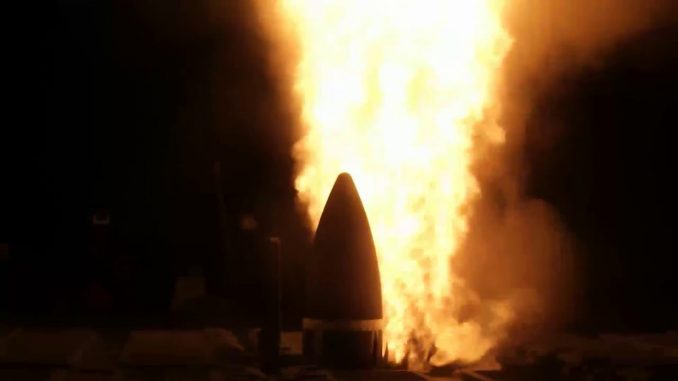
A recent announcement by the United States Missile Defence Agency is most interesting but has received almost no traction in the mainstream media given that it doesn't have any link to either the U.S. presidential election or the seemingly never-ending COVID-19 narrative. Nonetheless, the announcement is of particular interest given that it will have a significant impact on Washginton's view of a unipolar world and how it is perceived by its two main competitors, Russia and China.
Here is the announcement:
For the first time, a test of the Aegis Ballistic Missile Defence System or BMD, officially referred to as the Flight Test Aegis Weapon System-44 or FTM-44 (codenamed Stellar Lancer) has successfully intercepted and destroyed a "threat-representative" Intercontinental Ballistic Missile (ICBM) during a flight demonstration held in the Pacific Ocean to the northeast of Hawaii. The missile was launched from the Ronald Reagan Ballistic Missile Defence Test Site or Kwajalein Atoll and the intercepting missile was lancuhde from the Arleigh Burke-class destroyer, John Finn which is equipped with the AEGIS Basline 9 system. This is the sixth test flight of an Aegis BMD-equipped vessel using the Standard Missile 3 (SM-3) Block IIA guided missile. It was originally scheduled for May 2020 but was cancelled because of the COVID-19 pandemic's impact on personnel and equipment movements.
Here is a quote about the test from Vice Admiral Jon Hill:
We have demonstrated that an Aegis BMD-equipped vessel equipped with the SM-3 Block IIA missile can defeat an ICBM-class target, which is a step in the process of determining its feasibility as part of an architecture for layered defense of the homeland.”
Here is a YouTube video showing the test as filmed by Mark Wright of the Missile Defence Agency from the perspective of Raytheon Missile & Defense, the manufacturer of the Standard Missile 3 (SM-3) Block 2A ballistic missile defence interceptor:
If you click here, you can see a Missile Defence Agency animation of the test.
Here is a screen capture showing the SM-3 Interceptor's webpage:
The SM-3 interceptor does not use an explosive warhead to destroy its target, rather, it uses the force that it builds during flight in a "hit-to-kill" technique which it likens to hitting a target with a 10 ton truck travelling at 600 mph. The SM-3 interceptor is both land- and sea-based.
Now, let's look at what Russia thinks about this test from the perspective of a writer on RT, Russia's state media outlet:
"Russia has long held that the deployment of anti-ballistic missile systems in Europe represented a major alteration of the strategic balance of power, insofar as it empowered a potential US/NATO nuclear first strike scenario, in which US nuclear-armed missiles would be launched against Russian strategic nuclear forces in an effort to preemptively destroy them. Europe would then avoid the certainty of mutually assured destruction by hiding behind the US missile defense shield, which in theory would be capable of shooting down the handful of Russian missiles that might survive such an attack.
The SM-3 Block IIA interceptor represents a great threat to Russia. When deployed from aboard Baseline-9 equipped Arleigh Burke-class destroyers integrated into the C2BMC network, the SM-3 Block IIA interceptor becomes the anchor of a potentially global missile defense shield capable of nullifying the ICBM strike potential of all would-be adversaries–including Russia….
By putting the SM-3 Black IIA interceptor to the test as an anti-ICBM weapon, the US has made the New START treaty irrelevant overnight, testing the willingness of Russia to agree to an extension. Even if Russia does allow the New START treaty to be extended, there is little doubt that it will insist on meaningful and verifiable limits to US ballistic missile defense capabilities, including the SM-3 Block IIA interceptor, before Russia could sign on to a new follow-on strategic arms reduction treaty.
More critically is what the new SM-3 Block IIA does to the current Russian nuclear posture, which is already being re-evaluated in light of the decision by the US to deploy low-yield nuclear warheads onboard US missile-carrying submarines.
The combination of low-yield nuclear weapons on board US submarines lurking off Russia’s coast with US destroyers equipped to shoot down Russian ICBMs is the stuff of any Russian nuclear planner’s worst nightmare. Russia will most likely be compelled to reexamine its alert posture to account for the increased possibility that the US may seek to launch a preemptive decapitation attack using low-yield nuclear weapons."
Here's what China's leadership has to say about this test from the perspective of the Global Times, a media outlet of China's government:
"While the ICBM is a mock one, it could have serious consequences, as the test could break down the mutual nuclear deterrence maintained by the world's nuclear powers for decades, Forbes magazine said on Wednesday.
Citing US experts, the report said that the test will lead China and Russia to believe the US could contain their nuclear retaliatory capabilities in the future, and it will be harder to limit missile defenses in an arms control agreement.
While the test showed the US' advanced level in ballistic missile defense, it will not yield such significant impact to the current balance in nuclear deterrence in the world, Chinese experts said.
The test used only a mock missile, and was done under an optimal scenario in which the defending side knows where and when the missile would come from, so it is very questionable to what extent the test could represent a real-battle scenario where the missile could be launched from unpredictable locations and at an unknown time, given both China and Russia operate road-mobile ICBMs and submarine-launched ballistic missiles, a military expert who asked for anonymity told the Global Times on Thursday.
A traditional ICBM, which is not hypersonic, was used in the simulation so it does not have the capability to actively change trajectory in mid-flight. That means it is much easier to intercept, the expert said, noting that China and Russia are developing and commissioning more advanced missiles, including hypersonic ones.
Wang Ya'nan, chief editor of Beijing-based Aerospace Knowledge magazine, told the Global Times on Thursday that the US ballistic missile defense technology should be considered advanced, but ballistic missile technologies are also changing.
Since the US is seeking to enhance counters, countries like China and Russia are forced to improve their traditional missiles, which in turn brings about more challenges to the defending side, Wang said."
I do find it interesting that China is focussing on the fact that the ICBM was a mock model and that the scenario was staged which allowed the defending ship's AEGIS system to know where and when the missile would be launched.
From the perspective of both Russia and China, the successful test of the Aegis system November 17, 2020 is an escalation of the ongoing geopolitical tension that has grown over the past half decade. Unfortunately, in the case of a nuclear exchange, there are no winners, only billions of overcooked human beings.
Click HERE to read more from this author.
You can publish this article on your website as long as you provide a link back to this page.

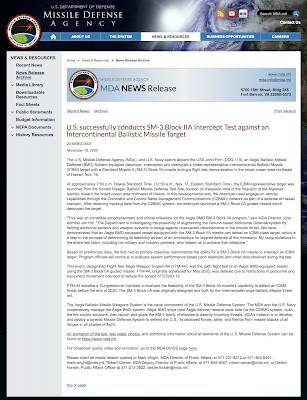
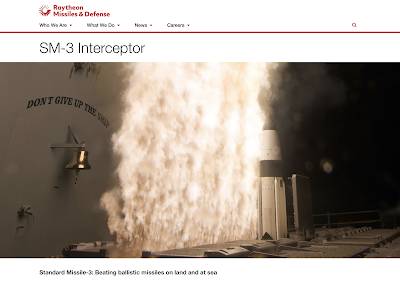
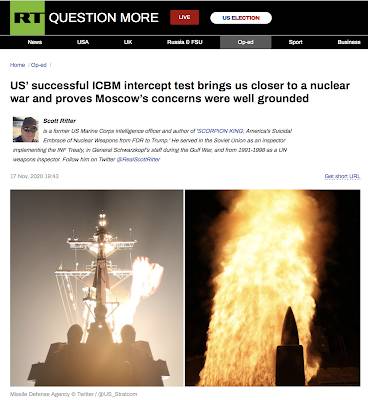
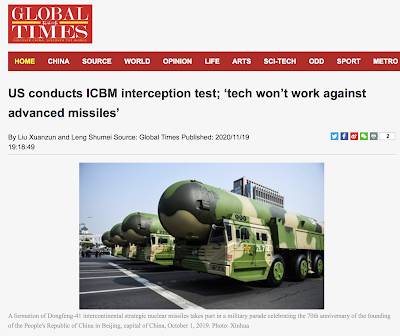
Be the first to comment